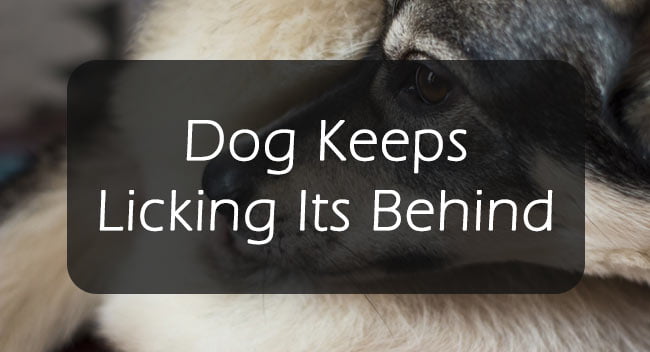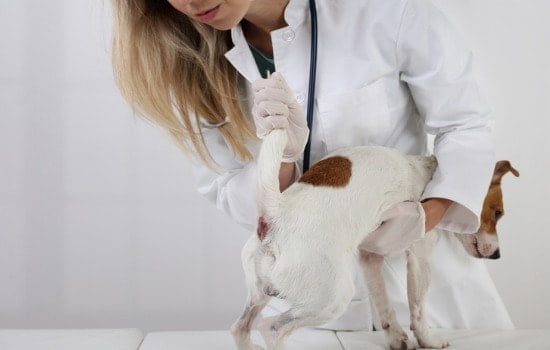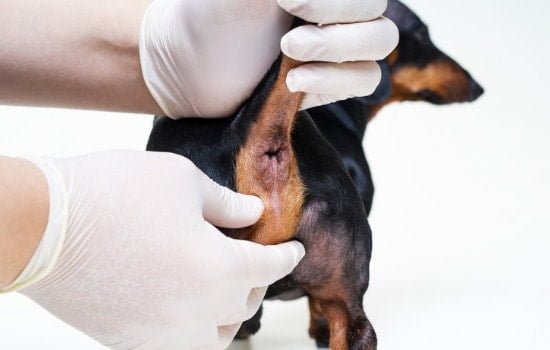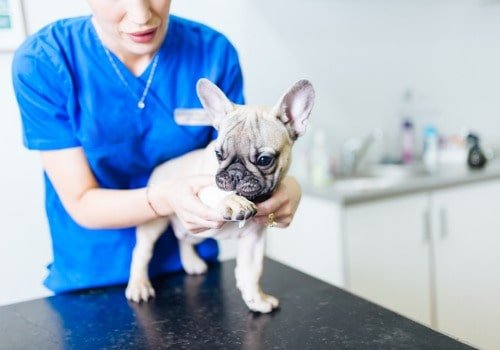Have you noticed your dog giving a lot of attention to their bottom for extended lengths of time? Perhaps you’ve seen your dog licking their behind repeatedly over several days, weeks, or months.
Most dog owners would agree that this behavior is unusual.
Dogs exhibit scooting, licking, and dragging rear-end behavior because they are in pain or discomfort.

An underlying health condition is generally causing this pain and discomfort.
Some of these conditions are minor and can be treated easily. More serious conditions can be life-threatening and need surgical treatment.
We’re going to focus on unusual behaviors like dog-licking butt tendencies.
If your dog keeps licking their anus or your dog is dragging their butt across the floor or ground outside, you’re definitely seeing patterns that may need medical attention.
Some of these behaviors may be caused by a minor problem, while others can be severe.
Here are five canine disorders that are associated with dogs being extra attentive to their bottom area.
- Anal sac disease
- Perianal fistulas
- Perineal hernia
- Anal tumors
- Rectal itching
In this article, we will cover five of the most common canine disorders associated with canine anal regions.
We will include a basic definition of the disorder, the signs and symptoms, breeds that are more susceptible to the disorder, and what a responsible owner can and should do to help.
Anal Sac Disease
If you notice that your dog keeps licking their anus or your dog is dragging their butt, it may due to a medical condition.
One of the associated medical conditions is anal sac disease.
This disorder is characterized by obstructed or infected anal sacs. Anal sacs are glands found on either side of the anus.
The condition is the most frequently diagnosed disorder of the anal area in canines.
The anal sacs on a dog are similar to the smell glands found in skunks. These glands can make low amounts of bad-smelling liquid.
This foul liquid is usually pushed out when the dog is pooping. These glands can become damaged in a variety of ways.
They can become blocked, infected, abscessed, or cancerous. There are many causes of obstructed anal sacs, including:
- Sacs are unable to be pushed out throughout defecation
- Weak muscle tone in overweight canines
- Anal sacs are secreting excessive amounts of fluid
In summary, when the obstructed anal sac contents are not expelled, the glands become at risk of inflammation, infection, and bacterial overgrowth.
Signs and Symptoms
There are numerous signs and symptoms of anal sac disease. Have you noticed your dog dragging their bum on the carpet?
Dogs who are scooting and dragging their bum on the carpet are two of the symptoms that can be caused by anal sac disease.
Another common sign of anal sac disease is your dog licking their butt. Here are some additional symptoms of this foul condition:
- The dog shows pain or discomfort when they are sitting
- The dog may bite or lick the painful region
- If the anal sacs are clogged, the area around the glands will feel hard
- The dog is in pain during defecation
- Intense pain and possible discoloration of the area, depending on the severity of the condition
- Open tracts of tissue that break open skin
- Tumors associated with the glands can occasionally be present
Dog Breeds Susceptible to Anal Sac Disease

Smaller breeds of dogs are more at risk of contracting anal sac disease.
For example, chihuahuas and poodles. Larger breeds of canines are seldom affected by the condition.
Other than the predisposition of smaller breeds, there are no other breeds of dogs that are more susceptible to developing anal sac disease.
What Can You Do?
If you notice that your dog keeps licking their anus, the first thing that you can do as an owner is to take your dog to the veterinarian.
This condition can become dangerous very quickly and needs to be treated immediately.

The vet will conduct examinations on the anal area and lay out a course of treatment.
When an infection is apparent, the vet will prescribe an antibiotic that should be given to your dog.
The application of hot compresses is another standard treatment method.
Furthermore, dietary changes may be necessary to ensure the condition does not return.
The most common nutritional change for anal sacs disease is adding fiber to the dog’s diet.
Perianal Fistulas
When you notice your dog scooting, dragging their butt, or dog licks their butt, it could be a sign of perianal fistulas.
Perianal fistulas are thin, unnatural structures within a canine’s skin and deep tissue that encompass the area around the anus.
These formations can be small and minor or more substantial and severe.
The lesions originate as tiny holes in your canine’s skin.
Over time, they grow more extensive and deeper. If the condition is left untreated, they can surround a dog’s entire anus region.

Contamination of hair follicles and glands around the anus region can occur as a result of the perianal fistulas.
The contamination is caused by fecal matter.
Additionally, secretions from the anal sac can cause tissue damage and long-term inflammation of the surrounding tissue.
Signs and Symptoms
There are many symptoms associated with perianal fistulas.
One of the most common symptoms is the dog dragging their bum on the carpet.
The symptoms of this disorder can often be confused and appear like other problems in the anal region.
Here are some of the most common symptoms:
- The dog is showing signs of pain or discomfort while defecating
- The dog is having a hard time defecating
- Constipation
- Diarrhea
- The presence of mucus or blood in the stool
- Excessive biting and licking in the anal region
- Restless behavior
- Whimpering before or during defecation
Breeds Susceptible to Perianal Fistulas
The only specific dog breed that is known to be more susceptible to contracting perianal fistulas is the German Shepherd. However, the condition can appear in any canine.
What Can You Do?
Whenever you notice that your dog keeps licking their anus your dog is dragging their bum on the carpet, you should contact your veterinarian immediately.
Perianal fistulas are a severe condition; treatment usually lasts several months and maybe a lifelong condition.

Therefore, owners should seek veterinarian assistance regardless of the severity of the condition.
The disease will worsen if left untreated, and it will negatively affect the dog’s quality of life.
Your veterinarian will probably discuss several options for treatment, both medical and surgical.
This treatment option is aggressive because nearly 80% of cases of perianal fistulas will reappear even if the condition is effectively treated.
The veterinarian will list several additional treatment options, including:
- Dietary changes
- Antibiotic medications
- Anti-inflammatory medication
- Additional varieties of veterinary medications
Surgical treatment aimed at removing the affected area may also be suggested.
This condition can become so severe and painful for the dog that surgical removal of the tail is occasionally recommended.
Perineal Hernias
A dog licking their butt or doing the dog butt scoot can be associated with a condition known as perineal hernias.
The bottom of the pelvis region holds the rectum and retains the contents of the abdomen in their standard position.
When the muscular structure of this region is weakened, it may break entirely, which allows organs to become trapped inside of the hernia.
Perineal hernias first appear as inflammation around the rectum.
A perineal hernia is a severe condition for your dog.
In cases where the bladder passes through into the hernia, emergency or surgical treatment may be required.
This condition can cause a variety of symptoms and related diseases because of its ability to affect multiple vital organs.
One of the most notable symptoms is the dog dragging their bum on the carpet.
The most troubling effect of the condition is that it can hinder your dog’s ability to urinate and defecate.
Additionally, a perineal hernia could be life-threatening if the bladder or intestine is associated with the rupture.
Signs and Symptoms
A perineal hernia is often recognized as an area of inflammation adjacent to or below the anus.
The following symptoms can occur as a result of the inflammation:
- Difficulty with urination and defecation
- Constipation
- Changes to the way your dog’s tail moves
- Abdomen discomfort, such as from gas pain
- Dog licking butt
- Reduced levels of energy
- Depression or decreased mood
- Dog dragging butt
- Dog butt scoot
Breeds Susceptible to Perineal Hernias
Before going into the specific breeds that are more susceptible, perineal hernias commonly occur in elderly, unneutered dogs.
This development and breakdown are caused by a dog’s body becoming weaker as it gets older.
The weakening of the perineal region is the most common cause of a perineal hernia.
A perineal hernia can occur in any dog breed, but they are significantly more common in these breeds:
- Pekingese
- Terrier
- Corgi
- Dachshund
- Boxer
- Kelpie
- Collie
- Sheepdog
What Can You Do?
Treatment of a perineal hernia is expensive and can be long-lasting.
The specific treatment depends on the severity of the hernia. Surgical treatment options are standard and typical for this condition.
Additionally, non-surgical treatment methods will be suggested for the management of the disease.
For a minor case of perineal hernia, veterinarians may prescribe the following treatment options:
- Stool softeners
- Enemas
- Change of diet, the addition of high-fiber dietary supplements
- Bladder decompression
Surgical treatment is often the primary treatment for perineal hernias.
Post-surgery, your vet will prescribe antibiotic medications to fight off infections and contamination.
Additionally, painkillers will be prescribed to help ease the dog’s pain after surgery.
Regular visits to the vet for check-ups and follow-ups will be necessary for a duration of time after the surgery.
Dogs that undergo the surgical method of treatment have a good prognosis as long as the hernia heals appropriately.
Anal Tumors
We have already covered the perianal glands in dogs and their function. Tumors can form on or around the perianal glands.
These tumors most commonly develop in elderly and spayed female dogs.
Some of the early symptoms of anal tumors in dogs include dog licking their butt, dog scooting, and dog dragging their bum on the carpet.
Benign tumors are usually harmless, and they can be effectively treated.
Malignant tumors are much more severe. The malignant type can be life-threatening and must be addressed immediately and aggressively.
An additional harmful effect of these tumors is that they can lead to kidney disease and kidney failure if left untreated.
Signs and Symptoms
There are many signs and symptoms associated with anal tumors in dogs.
Most of the symptoms will not cause pain to your dog.
But, owners will notice that their dog directs a significant amount of their attention toward their anal region.
These tumors can develop without the presence of symptoms for a few months up to several years.
Eventually, the masses can rupture and bleed, which puts your dog at risk for infection.
Here are some of the symptoms associated with anal tumors:
- A fat, circular formation of tissue around the anal area
- Bleeding tissue
- The dog keeps licking the anus
- The dog is scooting
- Pain in the rectal area
- Difficulty and pain associated with defecation
- Blood present in fecal matter
- The dog is vomiting blood
- Dog vomits and it smells like poop
- Dog shows increased thirst and urination
- Dog shows reduced appetite and energy and won’t eat or drink
- High levels of blood calcium
- Dog butt scoot
- Dog licking butt
Breeds Susceptible to Anal Tumors
The cause and reason that some dogs are more prone to the development of anal gland tumors remain largely unknown.
Male dogs are more at risk of developing this condition compared to females.
There are a few breeds that are thought to be at a higher risk of developing this condition:
- Beagle
- Cocker Spaniel
- Bulldog
- Samoyed
What Can You Do?
The treatment for anal tumors is dependent upon the severity and progression of the growths.
A surgical procedure is the standard method of fighting off these tumors.
In the case of a malignant tumor that has spread, the condition can be very life-threatening.
If the disease has progressed, treatment should be aimed at improving your dog’s quality of life and making him as comfortable as possible.
Chemotherapy and radiation therapy are generally recommended to be used in combination with surgical treatment.
More medical procedures include:
- Lotions for irritated anal skin
- Medication to decrease levels of blood calcium
- Medication aimed to improve kidney function
- Medication to help soothe pain and nausea
Rectal Itching
Rectal itching is a behavior that can suggest the presence of numerous symptoms that can lead to more dangerous conditions and complications.
Owners should be wary when they see a dog engaging in rectal itching for extended lengths of time.
The cause of rectal itching can be two of the conditions that were previously covered in this article, including anal sac disorder and anal tumors.
Rectal itching can be defined as the length of time a dog is licking their butt, scooting, or scratching the anal region.
Any sign of repeated or extended rectal itching should warrant a visit to the veterinarian because it likely indicates an additional health condition.
Signs and Symptoms
The signs and symptoms of rectal itching are not complicated and are easy to recognize.
Your dog will likely demonstrate the following behaviors if they are suffering from rectal itching:
- Dog butt scoot
- The dog is dragging the butt
- The dog is licking nearby the anal region
- Biting or scratching in the tail region or keeping their tail between their legs
- Behavioral changes
- Restlessness
- Signs of pain or discomfort
- Dog licking butt
Additional symptoms may be present depending on if there is an underlying cause of the rectal itching.
Breeds Susceptible to Rectal Itching
There is a variety of explanations for why your dog could be suffering from rectal itching. Food allergies can cause dogs to exhibit rectal itching. Breeds that are at risk for food sensitivity include:
- German Shepherd
- Dachshund
- Labrador
- Poodle
- Boxer
- Weimaraner
Smaller breeds of dogs are predisposed to developing anal gland impacting, which can lead to rectal itching.
The following breeds possess a higher risk of developing several conditions that can cause rectal itching:
- Basset Hound
- German Shepherd
- Terrier
- Shih Tzu
- Maltese
- Setter
- Cocker Spaniel
- Sheepdog
- Retriever
What Can You Do?
Treatment of rectal itching will be dependent upon the condition that is causing your dog to exhibit this behavior.
Some of the common ailments can be treated with standard medications. More severe conditions must be treated with surgery.
Here are some of the most common treatment options for conditions that are associated with rectal itching in dogs:
- Antibiotic medication
- Special medical shampoos and soaps
- Stool softeners
- Perianal cleaning
Finding the cause and removing your dog’s need for rectal itching will provide a tremendous amount of relief.
Veterinary follow-up visits will be required to ensure that the condition does not return.
Additionally, the vet will want to watch healing if any surgical procedure has been performed.
Conclusion
Dog butt licking is an irregular behavior that is usually caused by an underlying condition.
Similar irregular behaviors include dog scooting and dragging butt.
As an owner, if you notice your dog exhibiting these behaviors for extended periods, then it is time for a visit to the vet.
In some cases, it’s nothing more than a dog’s anal glands needing to be expressed or secreted. This video may put your mind at ease (but maybe not your stomach!).
The conditions associated with your canine giving too much attention to their anal region vary in severity and treatment options.
The conditions that are superficial and minor are usually treated with antibiotics and can be healed.
The more severe conditions have life-threatening consequences for your furry friend. These conditions will need you to make difficult decisions.
These health conditions usually need surgical treatment, and even then, full recovery isn’t guaranteed.
Dog owners should schedule a visit with their veterinarian at the first sign of change in your dog’s habits, such as licking their butt with their anal region.
